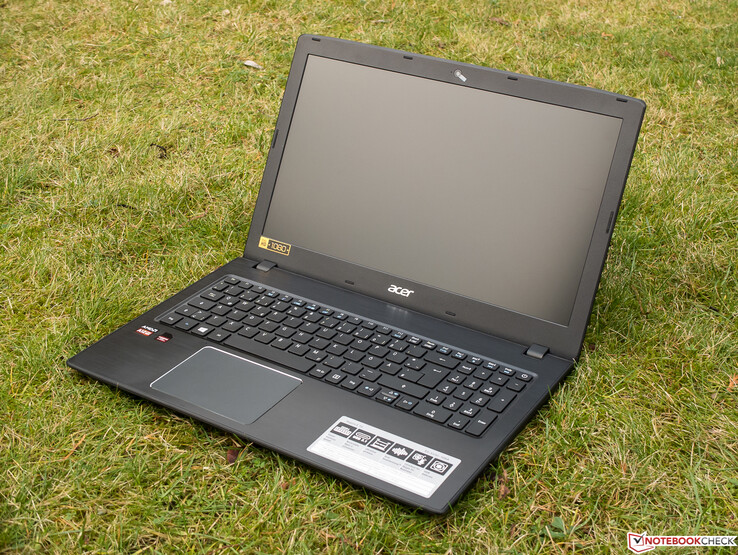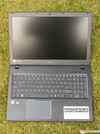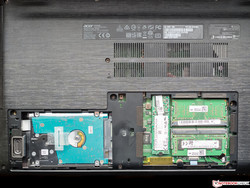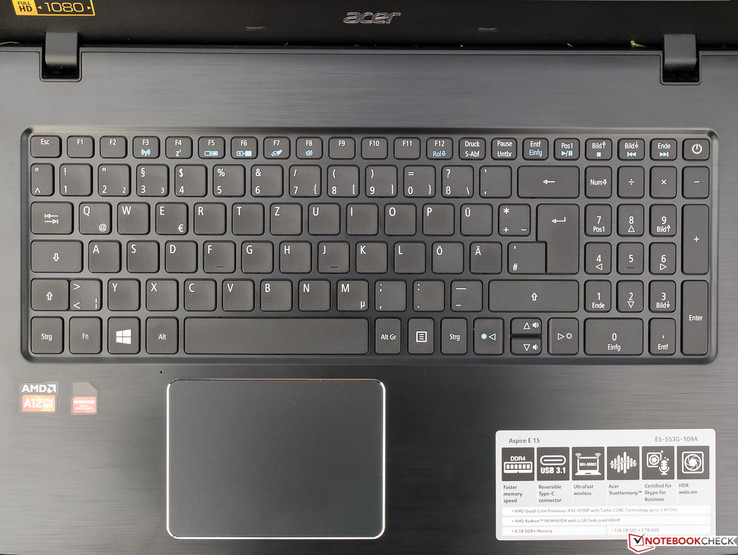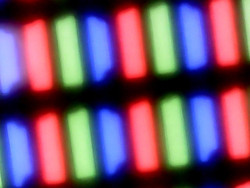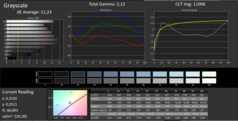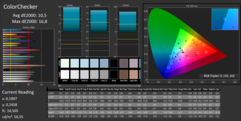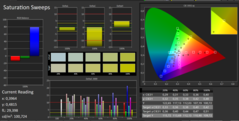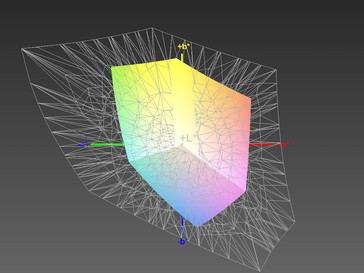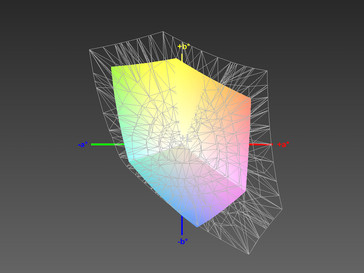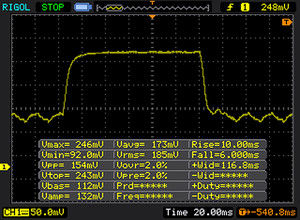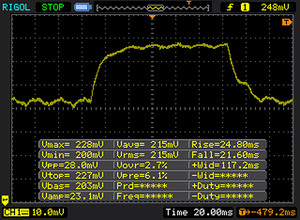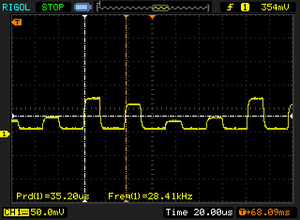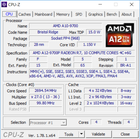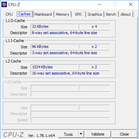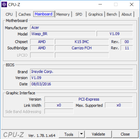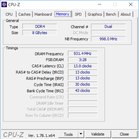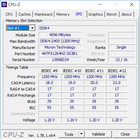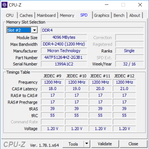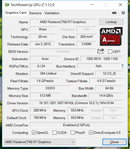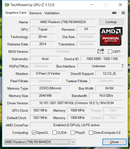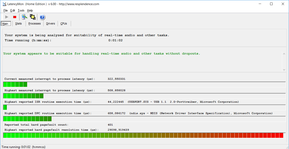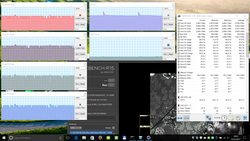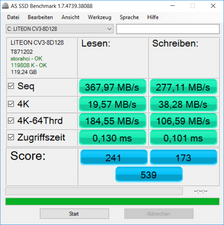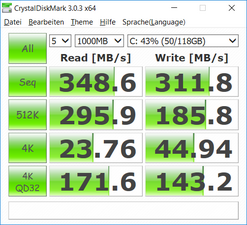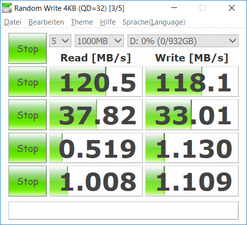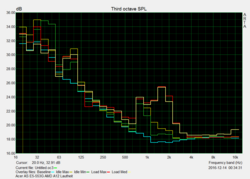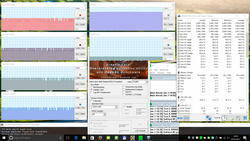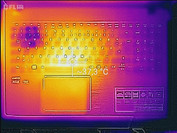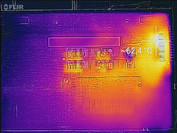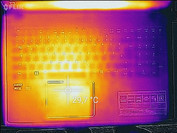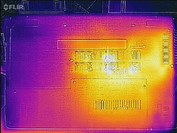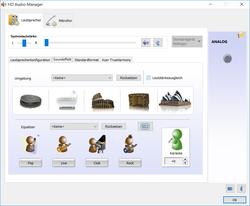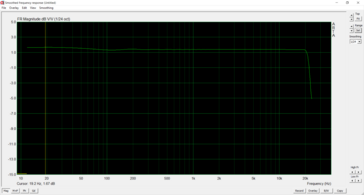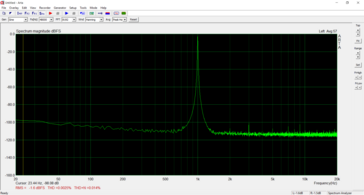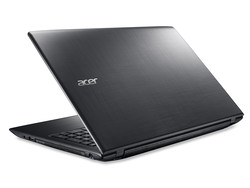Acer Aspire E5-553G-109A Notebook Review

For the original German review, see here.
The new Acer Aspire E5-553G-109A is an affordable 15.6-inch multimedia notebook, which, at the time of writing, was occasionally available for less than 700 Euros (~$747), but it will most likely become slightly cheaper with time. Acer went with a combination of the AMD A12-9700P quad-core ULV APU (2.5 - 3.4 GHz, TDP 15 W), 8 GB of RAM and the AMD Radeon R7 M440 dedicated graphics card that, together with the Radeon R7 integrated into the APU, forms the dual graphics Radeon R8 M445DX (Crossfire). There is also a 128 GB SSD and a regular 1 TB hard drive for mass storage. The TN display has a resolution of 1920x1080 pixels. Those who still want to watch or even burn DVDs will be pleased to find an optical drive.
As can be seen here, Acer does not list other possible variants, so we consulted a big price comparison based in Berlin. Besides the review model, they know two more versions with more than one price: 15FM and T48C. Because the listed specifications are not always correct and seem somewhat implausible in this case, and we also do not have any other information source at the moment, we cannot give any reliable information about the details and prices. There appears to be differences in the area of the display, RAM, mass storage, and graphics, but the case and the APU stay the same. Windows 10 Home is always preinstalled.
There is plenty of competition in the segment of affordable multimedia notebooks. For this review, we selected some current laptops with similar basic specifications for comparison that are in the same price category as the review unit. We did not find a suitable device with a current Intel Core i3, which is a shame, since the AMD-APU competes with exactly that series performance-wise.
The candidates are:
Case
Metal is hardly to be expected in the price category of this test device. So the upper side of the base, which is covered with a subtle brushed metal finish and is prone to fingerprints, is the only surface of the completely black and non-slippery Acer E5-553G that looks more like aluminum than plastic. The slightly brighter and thus almost gray lid is very resistant to fingerprints and has a textile pattern. Aside from that, there are hardly any optical accents. In general, the device is rather simple and masculine.
With some effort, the base can be flexed a bit and crackles gently, while the lid is relatively soft or rather flexible and definitely not pressure resistant. The manufacturing irregularities, which are at best minimal, have to be searched for with a magnifying glass. Overall, the solid case offers mainly one source of complaint: Despite the not very low weight of the base, the hinges do not enable the user to open the lid with one hand; they do stay in place well, however.
The laptops do not differ much in weight. The lightest device, the Lenovo IdeaPad 510, weighs only 200 grams less than the two Acer devices (about 2.4 kg). The relatively thick Medion Akoya (2.3 kg) takes up the most volume; the IdeaPad is the most compact and thin one.
Connectivity
Laying aside Thunderbolt and DisplayPort ports, which are hardly to be expected in this price range, the port selection is nothing to complain about. There are three super-speed capable USB ports; one is even USB Type-C. Gigabit Ethernet is available for stationary use, and even ancient display devices can be connected via the VGA port. The right USB port comes with the 2.0 standard, which is irrelevant for those users who will plug their external mouse into that port.
The unergonomic positioning of the ports deserves criticism, because almost all have landed in the front, putting cables and drives in the way. With both USB 3.0-ports occupied, it could get tight.
SD-Card Reader
Just to mention the ranking: Numerous notebooks in our database achieve average speeds of 100 to an exorbitant 213 MB/s when reading typical JPG files on our reference SD-card (Toshiba Exceria Pro SDXC 64 GB UHS-II). The overall average is 63 MB/s. With this in mind, the SD-card reader performs decently, especially for the price range of the laptop, though slightly below average. The Acer Aspire E5-575G is not far behind, while the USB 2.0-level of the other two candidates' card readers slows down the user.
| SD Card Reader | |
| average JPG Copy Test (av. of 3 runs) | |
| Acer Aspire E15 E5-553G-109A | |
| Acer Aspire E5-575G-549D | |
| Medion Akoya P6670 | |
| Lenovo Ideapad 510-15ISK | |
| maximum AS SSD Seq Read Test (1GB) | |
| Acer Aspire E15 E5-553G-109A | |
| Acer Aspire E5-575G-549D | |
| Medion Akoya P6670 | |
| Lenovo Ideapad 510-15ISK | |
Communication
The Internet can also be accessed wirelessly, not just via Gigabit LAN. The task is accomplished by the Qualcomm Atheros QCA9377 Wireless Network Adapter (MIMO 1x1), which has Bluetooth 4.1 integrated and supports the 5 GHz 802.11ac standard, theoretically achieving a throughput of 433 MBit/s. The user has to do without Intel specialties such as Wireless Display. Using our reference router Linksys EA8500 and bearing in mind the overhead, we achieved 333 MBit/s while receiving and 346 MBit/s while sending. This is not fast in comparison with many MIMO-2x2 modules, but it is alright for a design with one antenna.
| Networking | |
| iperf3 receive AX12 | |
| Acer Aspire E15 E5-553G-109A | |
| iperf3 transmit AX12 | |
| Acer Aspire E15 E5-553G-109A | |
Accessories
Buyers of more affordable notebooks do not need to fret, because even in boxes of devices worth 2,000 Euros (~$2137), you will rarely find more than the obligatory power supply as well as set-up and warranty information. Acer does not sell any accessories specifically designed for the E5-553G.
Maintenance
Warranty
For the E5-553G, Acer grants a 24-month manufacturer warranty (pick-up and return). Some sellers offer the option to expand the warranty when purchasing the device, but not Acer.
Please see our Guarantees, Return Policies & Warranties FAQ for country-specific information.
Input Devices
Keyboard
While the main part of the slightly recessed keyboard is only a few millimeters narrower than on a standard desktop keyboard, the numerical keypad is much smaller in comparison and results in significantly restricted use, at least for buyers with larger hands. The layout does not bear many surprises. As is typical of Acer, brightness and volume landed as a second function on the partly halved cursor keys below the right Shift key. Additionally, the on/off button was integrated into the upper right corner of the numerical keypad.
Haptically, the construction makes a good impression. The standard keys (letters, numbers, punctuation characters) are slightly concave and have a roughened surface, just as the other, flat keys. The sizes of the keys and the gaps between them are not an obstacle for fast 10-finger typing acrobats. At the beginning of the flat keystroke, a clear pressure point can be felt; at the end, at least with the concave keys, there is a rather soft stop. As often, only the big keys, such as space, rattle noticeably and discourage from typing in noise-sensitive environments. There is no need to worry about the overall solid and decent keyboard bending.
Touchpad
The pleasantly big ClickPad can be used to the edges and has no physical keys. It is adorned with a stylish high-gloss edge. Rather dry fingers glide with very little resistance across the smooth surface, moist ones with a bit more resistance, but it is still pleasant. The cursor can be moved very precisely and reproduces even very fast movements. Double tapping to Drag & Drop always worked seamlessly.
We also like the spare mouse keys with a crisp pressure point, short travel and subtle acoustic feedback. In view of Windows 10's advanced configuration options for the touchpad with gestures with up to three fingers, manufacturers increasingly forego installing a manufacturer-specific driver, as is the case here.
Display
The author has not reviewed any TN panels for a few months, which led to a disillusionment when starting up the E5-553G. But in the affordable consumer section in which the test model is situated, it is still rare to come across IPS panels. Regardless of that, the maximal brightness of the matte Full HD screen (141 ppi), which can also be found in the Acer Aspire E5-575G-459D, is quite meager at 201 cd/m². The IdeaPad 510 and the Medion Akoya do a significantly better job, achieving very decent values of around 270 cd/m². Nevertheless, the brightness should suffice for the usual indoor scenarios.
The brightness distribution of 75% is far below the average. Subjectively, clouding can be noticed in a black image under certain viewing angles, though it is only noticeable with dark, homogeneous color areas. However, there is no sign of screen bleeding. Acer does not seem to offer alternative displays for this model.
| |||||||||||||||||||||||||
Brightness Distribution: 75 %
Center on Battery: 224 cd/m²
Contrast: 487:1 (Black: 0.46 cd/m²)
ΔE Color 10.5 | 0.5-29.43 Ø5
ΔE Greyscale 11.23 | 0.57-98 Ø5.3
59% sRGB (Argyll 1.6.3 3D)
38% AdobeRGB 1998 (Argyll 1.6.3 3D)
41.07% AdobeRGB 1998 (Argyll 2.2.0 3D)
59.2% sRGB (Argyll 2.2.0 3D)
39.72% Display P3 (Argyll 2.2.0 3D)
Gamma: 2.12
| Acer Aspire E15 E5-553G-109A Chi Mei CMN15C4 / N156HGE-EAB, , 1920x1080, 15.60 | Lenovo Ideapad 510-15ISK LG Philips LGD04A7 / LG Display LP156WF6-SPK2 , , 1920x1080, 15.60 | Acer Aspire E5-575G-549D Chi Mei CMN15C4, , 1920x1080, 15.60 | Medion Akoya P6670 LG Philips LP156WF6-SPK3, , 1920x1080, 15.60 | |
|---|---|---|---|---|
| Display | -1% | -3% | -4% | |
| Display P3 Coverage | 39.72 | 39.26 -1% | 38.57 -3% | 38.14 -4% |
| sRGB Coverage | 59.2 | 58.7 -1% | 57.4 -3% | 57.2 -3% |
| AdobeRGB 1998 Coverage | 41.07 | 40.59 -1% | 39.89 -3% | 39.43 -4% |
| Response Times | -53% | -28% | -50% | |
| Response Time Grey 50% / Grey 80% * | 42.4 ? | 40 ? 6% | 39 ? 8% | 42 ? 1% |
| Response Time Black / White * | 14.6 ? | 24 ? -64% | 24 ? -64% | 22 ? -51% |
| PWM Frequency | 28740 | 50 ? -100% | 50 -100% | |
| Screen | 25% | 1% | 15% | |
| Brightness middle | 224 | 284 27% | 176 -21% | 287 28% |
| Brightness | 201 | 276 37% | 169 -16% | 269 34% |
| Brightness Distribution | 75 | 80 7% | 91 21% | 74 -1% |
| Black Level * | 0.46 | 0.33 28% | 0.47 -2% | 0.65 -41% |
| Contrast | 487 | 861 77% | 374 -23% | 442 -9% |
| Colorchecker dE 2000 * | 10.5 | 7.21 31% | 8.83 16% | 5.42 48% |
| Colorchecker dE 2000 max. * | 16.8 | 15.12 10% | 14.01 17% | 9.54 43% |
| Greyscale dE 2000 * | 11.23 | 6.86 39% | 8.97 20% | 5.14 54% |
| Gamma | 2.12 104% | 2.46 89% | 2.43 91% | 2.48 89% |
| CCT | 11096 59% | 6726 97% | 10234 64% | 6952 93% |
| Color Space (Percent of AdobeRGB 1998) | 38 | 37 -3% | 36.8 -3% | 36 -5% |
| Color Space (Percent of sRGB) | 59 | 58 -2% | 57.3 -3% | 57 -3% |
| Total Average (Program / Settings) | -10% /
6% | -10% /
-4% | -13% /
-1% |
* ... smaller is better
With a black level of 0.46 cd/m², the Acer Aspire E5-553G will not win any trophies, but it also does not stand out negatively. Of the other rivals, only the Lenovo IdeaPad is a bit better, while the black level of the Medion (0.65 cd/m²) can be safely labeled as too high. Dividing the maximal brightness by the black level, you get a modest contrast of 487:1, assuring the E5-553G at least second place among its competitors. The only IPS panel in review, found in the Lenovo IdeaPad 510-15ISK, offers good contrast.
As for the color accuracy in factory default (ideally: Delta-E < 3), the Medion gets the best score, while the test model occupies last place with bad Delta-E values of 10 to 11 that are typical for TN panels. This is just one reason why it is not even suitable for hobby image editing. The panel widely misses the color temperature target of 6,500 K; the measured 11,096 K entails an extreme blue tint. The color profile linked in the box could improve this. The mediocre presentation of the display is rounded off with an only 38% coverage of the professional AdobeRGB color space (sRGB: 59%). None of the candidates can win an award in this category.
Good: It is a matte display. Not so good: It is not very bright by today's standards. Using the device in the garden on a dark, cloudy day was mostly fine, as long as the screen was not directed straight at the sky and the brightness was set to maximum. There should not be too many restrictions on sunny days either if you have a house entrance behind you (best case scenario, right picture). On a bright summer day, though, it will probably be difficult to discern anything outside of the shadow.
Display Response Times
| ↔ Response Time Black to White | ||
|---|---|---|
| 14.6 ms ... rise ↗ and fall ↘ combined | ↗ 9.4 ms rise | |
| ↘ 5.2 ms fall | ||
| The screen shows good response rates in our tests, but may be too slow for competitive gamers. In comparison, all tested devices range from 0.1 (minimum) to 240 (maximum) ms. » 31 % of all devices are better. This means that the measured response time is better than the average of all tested devices (21.5 ms). | ||
| ↔ Response Time 50% Grey to 80% Grey | ||
| 42.4 ms ... rise ↗ and fall ↘ combined | ↗ 22 ms rise | |
| ↘ 20.4 ms fall | ||
| The screen shows slow response rates in our tests and will be unsatisfactory for gamers. In comparison, all tested devices range from 0.2 (minimum) to 636 (maximum) ms. » 66 % of all devices are better. This means that the measured response time is worse than the average of all tested devices (33.7 ms). | ||
Screen Flickering / PWM (Pulse-Width Modulation)
| Screen flickering / PWM detected | 28740 Hz | ||
The display backlight flickers at 28740 Hz (worst case, e.g., utilizing PWM) . The frequency of 28740 Hz is quite high, so most users sensitive to PWM should not notice any flickering. In comparison: 53 % of all tested devices do not use PWM to dim the display. If PWM was detected, an average of 17915 (minimum: 5 - maximum: 3846000) Hz was measured. | |||
The lacking viewing-angle stability is definitely the biggest shortcoming of the overall not convincing display. The screen allows for very little room to move, even in comparison with many (current) TN colleagues. Moving just slightly away from the ideal position already brings about restrictions typical of TN panels, such as distorted colors, considerably decreasing brightness and loss of contrast.
Performance
Due to the dedicated graphics card, we classify the Acer Aspire E5-553G-109A as a multimedia notebook, but the CPU performance points more towards an office notebook and can at best rival the performance of an inexpensive Intel Core i3. Excessive multitasking can lead to small pauses, and while demanding programs such as Adobe Lightroom run decently, they do not run as smoothly as with a dual-core i5 with Hyper-Threading. The graphics performance is not much better; an Nvidia GeForce 920M(X) can serve as a guideline. But the AMD engine handles everyday tasks such as office software or browsing without any problems, not least thanks to the SSD support.
Processor
The AMD A12-9700P is a current quad-core ULV of the Bristol Ridge series with a TDP of 15 watts. It is also suitable for especially thin and compact laptops. Besides a Radeon R5 GPU, the chip also integrates a DDR4 memory controller (1.866 MHz) as the SoC, as well as the chipset that was formerly located on the motherboard. In comparison with the previous generation called Carrizo, no noteworthy architectural changes have been undertaken, only optimizations that allow for somewhat higher clock speeds. Our page about the APU linked at the beginning of this paragraph contains two links with more information on Bristol Ridge.
As for the processor performance, the APU operates approximately on the level of a current Intel dual-core i3, which, as is known, is not capable of Hyper-Threading. A CPU-Z analysis first highlights the low single-core performance, and the multicore performance is only about three times higher, despite having four cores. As long as there is no permanent full load, which noticeably brings down the clock speed, well parallelized programs can benefit from the four cores, in which case the A12-9700P can pull a bit ahead of the i3 rivals. The AMD-typical weak single-core performance is yet again noticeable and can be well observed in the discrepancy between the single- and multicore lag in comparison with the faster Intel CPUs with two cores along with Hyper-Threading. Our Cinebench loop creates a high, but still realistic load. After a few passes, the clock frequencies fluctuated only between 2.0 and 2.5 GHz in the multicore test. With regard to the base frequency of 2.5 GHz, we are already experiencing throttling. It is clear from the peaks of the temperature curve after the breaks between the passes that the system would like to keep the maximum CPU temperature at 64 °C. Running on battery does not change the Cinebench scores.
System Performance
As was to be expected, the system performance, measured with PCMark 8, is not fully affected by the in comparison weak CPU performance. Compared to the partly significantly more powerful rivals, the test device can assert itself especially well in the work sub-benchmark.
Subjectively speaking, the performance is mostly smooth, also due to the SSD. However, the E5-553G is partially more sluggish than an otherwise comparably equipped notebook with an Intel Core i5 or better. This can be noticed when quitting graphically intense games, where it often takes a few seconds longer for the system to stabilize itself.
| PCMark 8 | |
| Home Score Accelerated v2 | |
| Medion Akoya P6670 | |
| Lenovo Ideapad 510-15ISK | |
| Acer Aspire E5-575G-549D | |
| Acer Aspire E15 E5-553G-109A | |
| Work Score Accelerated v2 | |
| Acer Aspire E5-575G-549D | |
| Lenovo Ideapad 510-15ISK | |
| Acer Aspire E15 E5-553G-109A | |
| PCMark 8 Home Score Accelerated v2 | 2847 points | |
| PCMark 8 Work Score Accelerated v2 | 3844 points | |
Help | ||
Storage Devices
When sequentially transferring, SSDs attached via SATA 3 can achieve around 500 MB/s in the best case. The 128 GB Liteon model reaches only 300 MB/s, which could be noticeable when loading big games, for example, but is otherwise not so important. The results of loading small, dispersed data blocks (4K read), which are important for launching the operating system and programs, are more thrilling. In this case, 30 MB/s represents a good result, 40 MB/s an excellent one. Nonetheless, the 24 MB/s we measured is not an unusually bad result.
The regular HDDs found in some reference devices are no match for the SSDs. The one found in the Medion Akoya can pull ahead in some decisive sub-benchmarks, but it somewhat lags behind in writing performance. The noticeable differences probably stay within tight limits. The additional 1 TB hard drive does a good job.
| Acer Aspire E15 E5-553G-109A Liteonit CV3-8D128 | Lenovo Ideapad 510-15ISK Seagate Momentus SpinPoint M8 ST1000LM024 HN-M101MBB | Acer Aspire E5-575G-549D Toshiba MQ01ABD100 | Medion Akoya P6670 Phison S11-128G | |
|---|---|---|---|---|
| CrystalDiskMark 3.0 | -91% | -90% | 9% | |
| Read Seq | 348.6 | 84.5 -76% | 95.3 -73% | 441.8 27% |
| Write Seq | 311.8 | 69.9 -78% | 85.6 -73% | 398 28% |
| Read 512 | 295.9 | 28.87 -90% | 29.32 -90% | 295.5 0% |
| Write 512 | 185.8 | 28.08 -85% | 25.93 -86% | 75.5 -59% |
| Read 4k | 23.76 | 0.326 -99% | 0.366 -98% | 31.19 31% |
| Write 4k | 44.94 | 0.595 -99% | 0.726 -98% | 60 34% |
| Read 4k QD32 | 171.6 | 0.602 -100% | 0.647 -100% | 258 50% |
| Write 4k QD32 | 143.2 | 0.612 -100% | 0.722 -99% | 85.7 -40% |
Graphics Card
The AMD Radeon R8 M445DX is a dual-graphics composite of a dedicated Radeon R7 M440 with its own 2 GB of DDR3-RAM and the Radeon R5 GPU integrated into the APU. In Crossfire mode, they alternately compute one frame respectively. While the FPS should suffice, the different intervals between the frames can result in dropped frames; however, they are hardly noticeable and we barely encountered any in our gaming tests. AMD has apparently built good drivers. More details about the GPUs can be found in the links above.
In comparison with a single Radeon R7 M440, this construction makes absolutely no difference in terms of performance. You could get rid of the dropped frames by deactivating the dual graphics without having to suffer from lower frame rates. Overall, the device reaches the low level of a dedicated Nvidia GeForce 920M, but the 3DMark scores present some peculiarities: The R8 M445DX can almost compete with a GeForce GTX 950M in 3DMark 11 and is approximately 50 to 60% ahead of the two candidates with a 940MX. Even though it seems impossible, the Acer E5-553G scores better than the IdeaPad 510 with a 940MX in the Fire Strike test of the newer 3DMark (2013). The Cloud Gate benchmark of the same suite also does not restore the expected results. Without a power supply, the overall score of the newer 3DMark sank by 18%.
| 3DMark 11 - 1280x720 Performance GPU | |
| Acer Aspire E5-575G-549D | |
| Acer Aspire E15 E5-553G-109A | |
| Medion Akoya P6670 | |
| Lenovo Ideapad 510-15ISK | |
| 3DMark | |
| 1280x720 Cloud Gate Standard Graphics | |
| Acer Aspire E5-575G-549D | |
| Acer Aspire E15 E5-553G-109A | |
| Lenovo Ideapad 510-15ISK | |
| 1920x1080 Fire Strike Graphics | |
| Acer Aspire E5-575G-549D | |
| Acer Aspire E15 E5-553G-109A | |
| Lenovo Ideapad 510-15ISK | |
| 3DMark 11 Performance | 2992 points | |
| 3DMark Cloud Gate Standard Score | 6270 points | |
| 3DMark Fire Strike Score | 1644 points | |
Help | ||
Gaming Performance
As already indicated, the Radeon M445DX barely surpasses the level of integrated Intel HD Graphics. If you expect a multimedia notebook to have at least mid-range graphics, you should look elsewhere. Older isometric games, such as Diablo III or StarCraft 2 or even the new FIFA, can often be smoothly displayed with medium presets at 1366x768 pixels. Even more is possible with graphically simple 3D games such as Counterstrike: GO. But reasonably current and demanding games such as COD: Black Ops 3 from 2015 are too much for the dual graphics, usually already at the lowest settings and 1024x768 or 1280x720 pixels. A resolution of 1366x768 was not an option in these games.
| low | med. | high | ultra | |
| The Witcher 3 (2015) | 24.3 | 15.3 | ||
| Rise of the Tomb Raider (2016) | 23.9 | 14.8 | ||
| Battlefield 1 (2016) | 31.2 | 7.9 | ||
| Civilization VI (2016) | 36.8 | 9.7 | ||
| Farming Simulator 17 (2016) | 63.8 | 21.6 | ||
| Dishonored 2 (2016) | 13.8 |
| low | med. | high | ultra | |
| Dota 2 Reborn (2015) | 51 | 23 | 20.6 | |
| Resident Evil 7 (2017) | 40.7 | 16.4 | ||
| For Honor (2017) | 28.9 | 10.5 | ||
| Mass Effect Andromeda (2017) | 9.8 | |||
| Rocket League (2017) | 73.7 | 31.2 | 18.6 | |
| Dirt 4 (2017) | 47.6 | 18.5 | ||
| Playerunknown's Battlegrounds (PUBG) (2017) | 22.3 |
Emissions
System Noise
First, we activated the energy-saving mode with a passive system cooling guideline and discovered that the fan is always on, even under no load. The E5-553G can consistently be heard within a radius of one meter, but the subtle, gentle noise did not disturb the reviewer at all. Bringing up a YouTube video did not increase the rotation speed. Adding more or more demanding tasks can elicit some audible swooshing.
After activating Prime95 and FurMark, it takes about 10 seconds for the fan to pick up speed. A high-frequency noise with a moderate disturbance level can be heard occasionally after the fan passes the middle speed stages. This turns into a harmless noise a few minutes later, not distinguishable from the everyday background noise of a quiet office if you stand at least two meters away. All in all, the reviewer had hardly any problems with the noise.
Noise Level
| Idle |
| 31.4 / 31.4 / 31.9 dB(A) |
| DVD |
| 36.6 / dB(A) |
| Load |
| 33.7 / 33.8 dB(A) |
 | ||
30 dB silent 40 dB(A) audible 50 dB(A) loud |
||
min: | ||
Temperature
The surface temperatures on the bottom reach up to 56.5 °C under maximal permanent load, which can become quite uncomfortable when using the laptop on your lap. This scenario is hardly realistic, though. The temperature on the upper side never goes beyond 37 °C, more or less matching human body temperature. The areas left and right of the ClickPad never exceed 32 °C. In practice, the temperatures should be of minor importance.
Soon after launching our unrealistic stress test (Prime95 and FurMark), the CPU's core rates kept jumping between 1.6 and 2.1 GHz. The throttling we already discovered with Cinebench is thus reinforced by a simultaneous load of the APU-GPU. HWiNFO64 measured maximum temperatures of 80 °C, which can be borderline for AMD. However, it is not sure whether the reading was performed correctly.
(+) The maximum temperature on the upper side is 36.8 °C / 98 F, compared to the average of 36.9 °C / 98 F, ranging from 21.1 to 71 °C for the class Multimedia.
(-) The bottom heats up to a maximum of 56.5 °C / 134 F, compared to the average of 39.1 °C / 102 F
(+) In idle usage, the average temperature for the upper side is 25 °C / 77 F, compared to the device average of 31.2 °C / 88 F.
(±) The palmrests and touchpad can get very hot to the touch with a maximum of 36.6 °C / 97.9 F.
(-) The average temperature of the palmrest area of similar devices was 28.8 °C / 83.8 F (-7.8 °C / -14.1 F).
Speakers
The Realtek driver menu (right) does not offer many settings, so we stayed with the clean factory presets. The two downward-firing speakers produce a somewhat hollow sound with accentuated mids and highs. Even with harmless titles such as "1979" by The Smashing Pumpkins, the sound leans towards distortions at peak levels, but not volume fluctuations.
While real bass reproduction is naturally impossible, the sound has an undeniable dynamic and even hints (!) of three-dimensionality. Speech in movies does not sound overly natural, but it is comprehensible. The maximum volume fills medium-sized rooms well. As a whole, we rate the sound system as slightly above average and adequate for the price of the device.
Acer Aspire E15 E5-553G-109A audio analysis
(±) | speaker loudness is average but good (76 dB)
Bass 100 - 315 Hz
(-) | nearly no bass - on average 24.7% lower than median
(±) | linearity of bass is average (10.6% delta to prev. frequency)
Mids 400 - 2000 Hz
(+) | balanced mids - only 4.4% away from median
(±) | linearity of mids is average (12.4% delta to prev. frequency)
Highs 2 - 16 kHz
(±) | higher highs - on average 7.3% higher than median
(±) | linearity of highs is average (7.5% delta to prev. frequency)
Overall 100 - 16.000 Hz
(±) | linearity of overall sound is average (25.4% difference to median)
Compared to same class
» 89% of all tested devices in this class were better, 2% similar, 9% worse
» The best had a delta of 5%, average was 18%, worst was 45%
Compared to all devices tested
» 74% of all tested devices were better, 5% similar, 20% worse
» The best had a delta of 4%, average was 25%, worst was 134%
Lenovo Ideapad 510-15ISK audio analysis
(-) | not very loud speakers (70 dB)
Bass 100 - 315 Hz
(-) | nearly no bass - on average 23.7% lower than median
(±) | linearity of bass is average (11.1% delta to prev. frequency)
Mids 400 - 2000 Hz
(+) | balanced mids - only 1.9% away from median
(+) | mids are linear (6.5% delta to prev. frequency)
Highs 2 - 16 kHz
(+) | balanced highs - only 4.6% away from median
(+) | highs are linear (4.1% delta to prev. frequency)
Overall 100 - 16.000 Hz
(±) | linearity of overall sound is average (21.2% difference to median)
Compared to same class
» 69% of all tested devices in this class were better, 8% similar, 23% worse
» The best had a delta of 5%, average was 18%, worst was 45%
Compared to all devices tested
» 54% of all tested devices were better, 7% similar, 39% worse
» The best had a delta of 4%, average was 25%, worst was 134%
Acer Aspire E5-575G-549D audio analysis
(±) | speaker loudness is average but good (80.2 dB)
Bass 100 - 315 Hz
(-) | nearly no bass - on average 17.8% lower than median
(-) | bass is not linear (16.6% delta to prev. frequency)
Mids 400 - 2000 Hz
(+) | balanced mids - only 4.7% away from median
(±) | linearity of mids is average (10.8% delta to prev. frequency)
Highs 2 - 16 kHz
(+) | balanced highs - only 2.7% away from median
(+) | highs are linear (6.5% delta to prev. frequency)
Overall 100 - 16.000 Hz
(±) | linearity of overall sound is average (25.1% difference to median)
Compared to same class
» 88% of all tested devices in this class were better, 3% similar, 9% worse
» The best had a delta of 5%, average was 18%, worst was 45%
Compared to all devices tested
» 73% of all tested devices were better, 6% similar, 21% worse
» The best had a delta of 4%, average was 25%, worst was 134%
Medion Akoya P6670 audio analysis
(±) | speaker loudness is average but good (74 dB)
Bass 100 - 315 Hz
(±) | reduced bass - on average 10.8% lower than median
(+) | bass is linear (6.1% delta to prev. frequency)
Mids 400 - 2000 Hz
(+) | balanced mids - only 3.7% away from median
(+) | mids are linear (6% delta to prev. frequency)
Highs 2 - 16 kHz
(+) | balanced highs - only 1.3% away from median
(+) | highs are linear (3.9% delta to prev. frequency)
Overall 100 - 16.000 Hz
(+) | overall sound is linear (12.1% difference to median)
Compared to same class
» 15% of all tested devices in this class were better, 2% similar, 83% worse
» The best had a delta of 5%, average was 18%, worst was 45%
Compared to all devices tested
» 7% of all tested devices were better, 2% similar, 91% worse
» The best had a delta of 4%, average was 25%, worst was 134%
Frequency diagram comparison (checkboxes are selectable/deselectable)
The headset port was tested using Arta and directly connecting the line-out to the line-in. The results were quite good, with a linear frequency response (sinus sweep) and good THD+N, THD and SNR (98 dB) values.
Energy Management
Power Consumption
A comparison of notebooks with similar motorization would be of course interesting at this point, but there are none in our database (so far). So, for the sake of simplicity, we shall stick to our 15.6-inch comparison laptops. In all idle/load states, the Acer Aspire E5-553G-109A consumes only marginally less than the faster Lenovo IdeaPad 510-15ISK with an i5-6200U, Nvidia GeForce 940MX and Full HD IPS display. However, it consumes more power than the notebooks by Acer (E5-575G) or Medion that are also equipped with dedicated Nvidia graphics cards. Under load (avg, max), the picture is inconsistent, the most likely reason for that being the CPU throttling of the device under review and/or the 65-watt power supply.
| Off / Standby | |
| Idle | |
| Load |
|
| Acer Aspire E15 E5-553G-109A A12-9700P, Radeon R8 M445DX, Liteonit CV3-8D128, TN LED, 1920x1080, 15.60 | Lenovo Ideapad 510-15ISK 6200U, GeForce 940MX, Seagate Momentus SpinPoint M8 ST1000LM024 HN-M101MBB, IPS, 1920x1080, 15.60 | Acer Aspire E5-575G-549D i5-7200U, GeForce GTX 950M, Toshiba MQ01ABD100, TN, 1920x1080, 15.60 | Medion Akoya P6670 6200U, GeForce 940MX, Phison S11-128G, IPS, 1920x1080, 15.60 | |
|---|---|---|---|---|
| Power Consumption | 0% | 3% | 12% | |
| Idle Minimum * | 7.2 | 7.7 -7% | 6 17% | 6.7 7% |
| Idle Average * | 10.3 | 11.7 -14% | 8.1 21% | 9.2 11% |
| Idle Maximum * | 11.9 | 13.6 -14% | 9.8 18% | 9.7 18% |
| Load Average * | 48.2 | 48.3 -0% | 52.5 -9% | 40.6 16% |
| Witcher 3 ultra * | 51.8 | |||
| Load Maximum * | 63 | 41 35% | 81.6 -30% | 58 8% |
* ... smaller is better
Battery Life
This category also lacks useful comparisons. In our realistic WLAN test with the brightness set to medium (how we test), the E5-553G (40 Wh) runs for about 4 hours, which is approximately equal to the Medion Akoya that has a 44 Wh battery. Compared to the efficient and faster IdeaPad 510 (30 Wh), the test device does not get good results. The IdeaPad is even ahead in idle and load tests (24% and 33%, respectively), despite its smaller battery (30 Wh); it is slightly behind in the WLAN test, though.
| Acer Aspire E15 E5-553G-109A A12-9700P, Radeon R8 M445DX, 40 Wh | Lenovo Ideapad 510-15ISK 6200U, GeForce 940MX, 30 Wh | Acer Aspire E5-575G-549D i5-7200U, GeForce GTX 950M, 62 Wh | Medion Akoya P6670 6200U, GeForce 940MX, 44 Wh | |
|---|---|---|---|---|
| Battery Runtime | 15% | 75% | 9% | |
| Reader / Idle | 358 | 443 24% | 767 114% | |
| WiFi v1.3 | 257 | 225 -12% | 451 75% | 280 9% |
| Load | 55 | 73 33% | 75 36% | |
| H.264 | 460 |
Verdict
Pros
Cons
The Acer Aspire E5-553G-109A's features we like best are the decent (keyboard) to very good (ClickPad) input devices as well as the solid and well manufactured case. The AMD processor is better suited for office applications and struggles with some shortcomings such as throttling, suboptimal use of the four cores, and weak single-core performance. It rarely even pulls ahead of the dual-core i3s without Hyper-Threading when it comes to multitasking. The pointless Radeon R8 M445DX dual-graphics construction is to be criticized. For the most part, it does not achieve additional FPS in comparison with the dedicated R7 M440 but increases the danger of minor dropped frames. In the end, this does not matter, as the dual-graphics solution can be turned off and the R7 M440 can accomplish tasks on its own, which we recommend. If you avoid a persistent high load, the AMD technology performs so well in practice that a largely smooth operation is guaranteed. The SSD, of course, plays a contributing part.
The biggest weakness of the Acer newcomer is undoubtedly the subpar TN display that makes it difficult to find even one positive point. With a screen like that, a purchase recommendation is far away.
Especially the subpar viewing-angle stability is nothing more than an impertinence, despite the fact that the quality of the display is still not very important to many laptop users. Additionally, there is a banding of color gradients, which we have not seen in a long time, and this probably indicates a reduced color depth.
The port selection including USB Type-C, on the other hand, is good for this price range, even though the ports are not placed well. The WLAN module also does a good job, considering it has only one antenna. That Acer builds in a maintenance hatch is a praiseworthy exception these days.
Let us be frank: From our point of view, there is hardly any reason to choose the Acer E5-553G over any of the other multimedia notebooks in this review. Especially the Lenovo IdeaPad 510-15ISK, which is at best slightly more expensive, offers significantly more bang for the buck.
Acer Aspire E15 E5-553G-109A
-
01/18/2017 v6(old)
Sven Kloevekorn


 Deutsch
Deutsch English
English Español
Español Français
Français Italiano
Italiano Nederlands
Nederlands Polski
Polski Português
Português Русский
Русский Türkçe
Türkçe Svenska
Svenska Chinese
Chinese Magyar
Magyar